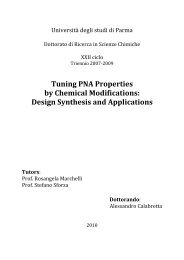Create successful ePaper yourself
Turn your PDF publications into a flip-book with our unique Google optimized e-Paper software.
Analytica Chimica Acta 562 (2006) 229–235<br />
Determination of hexavalent chromium in exhaled breath condensate and<br />
environmental air among chrome plating workers<br />
Abstract<br />
Matteo Goldoni a,b , Andrea Caglieri a , Diana Poli a,b , Maria Vittoria Vettori a,b ,<br />
Massimo Corradi a,b , Pietro Apostoli c , Antonio Mutti a,∗<br />
a Laboratory of Industrial Toxicology, Department of Clinical Medicine, Nephrology and Health Sciences, University of Parma,<br />
Via Gramsci 14, 43100 Parma, Italy<br />
b National Institute of Occupational Safety and Prevention, Research Centre at the University of Parma, Parma, Italy<br />
c Laboratory of Industrial Hygiene, Department of Experimental and Applied Medicine, University of Brescia, Italy<br />
Received 5 December 2005; received in revised form 18 January 2006; accepted 19 January 2006<br />
Available online 24 February 2006<br />
Chromium speciation has attracted attention because of the different toxicity of Cr(III), which is considered relatively non-toxic, and Cr(VI),<br />
which can cross cell membranes mainly as a chromate anion and has been classified as a class I human carcinogen. The aims of the present study<br />
were to measure soluble Cr(VI) levels in environmental samples, to develop a simple method of quantifying Cr(VI) in exhaled breath condensate<br />
(EBC), and to follow the kinetics of EBC Cr(VI) in chrome plating workers.<br />
Personal air samples were collected from 10 chrome platers; EBC was collected from the same workers immediately after the work shift on<br />
Tuesday and before the work shift on the following Wednesday. Environmental and EBC Cr(VI) levels were determined by means of colorimetry<br />
and electrothermal absorption atomic spectrometry, respectively.<br />
The method of detecting Cr(VI) in environmental air was based on the extraction of the Cr(VI)-diphenylcarbazide (Cr(VI)–DPC) complex in<br />
1-butanol, whereas EBC Cr(VI) was determined using a solvent extraction of Cr(VI) as an ion pair with tetrabutylammonium ion, and subsequent<br />
direct determination of the complex (Cr(VI)–DPC) in EBC.<br />
Kinetic data showed that airborne Cr(VI) was reduced by 50% in airway lining fluid sampled at the end of exposure and that there was a further<br />
50% reduction after about 15 h. The persistence of Cr(VI) in EBC supports the use of EBC in assessing target tissue levels of Cr(VI).<br />
© 2006 Elsevier B.V. All rights reserved.<br />
Keywords: Cr(VI); Speciation; Exhaled breath condensate; ETAAS; Chrome plating<br />
1. Introduction<br />
Chromium (Cr) is present in the environment in two main oxidation<br />
states: Cr(III) and Cr(VI). Whereas Cr(III) can be present<br />
in non-polluted environments, Cr(VI) is largely anthropogenic.<br />
Both forms are detectable in the workplace air of stainless steel<br />
production plants, chromium plating plants, chromium pigment<br />
factories, etc. [1]. Chromium speciation has attracted a great<br />
deal of attention because of the differential toxicity of its stable<br />
species: Cr(III) cannot usually cross cell membranes and its toxicity<br />
is considered to be relatively low [2,3], whereas Cr(VI) is<br />
transported through anion channels as chromate (CrO4 2− ) [4],<br />
∗ Corresponding author. Tel.: +39 0521 033075; fax: +39 0521 033076.<br />
E-mail address: antonio.mutti@unipr.it (A. Mutti).<br />
0003-2670/$ – see front matter © 2006 Elsevier B.V. All rights reserved.<br />
doi:10.1016/j.aca.2006.01.065<br />
and its reduction by different intracellular components (such as<br />
glutathione, ascorbate, tocopherols and different enzyme cofactors)<br />
generates stable Cr(III) or unstable Cr(IV) and Cr(V) intermediates,<br />
all of which are capable of forming complexes with<br />
peptides, proteins and DNA, and generating oxidative stress in<br />
vitro and in vivo, though Cr(VI) oxidizing potential in humans<br />
is not known with certainty [5–8]. Cr(VI) has been recognised<br />
as a highly toxic elemental species on the basis of experimental<br />
and epidemiological evidence, and has been classified as a class<br />
I human carcinogen by the International Agency for Research<br />
on Cancer (IARC) [2].<br />
In occupational settings, Cr(VI) exposure mainly occurs as<br />
a result of inhalation, and it is known that Cr(VI) compounds<br />
cause lung cancer [1]. The ex vivo monitoring of Cr species<br />
at the target organ level is important in occupational toxicology,<br />
because the measurement of total Cr in white and red blood cells
















